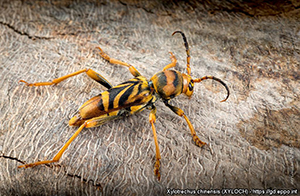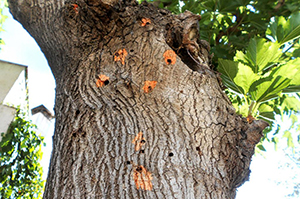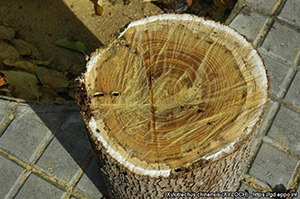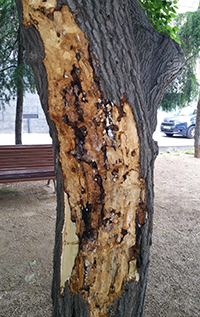
EPPO Alert List – Xylotrechus chinensis (Coleoptera: Cerambycidae)
Why
Xylotrechus chinensis (Coleoptera: Cerambycidae - Tiger longicorn beetle) is an Asian wood borer which has recently been found in two EPPO countries (Spain, Greece), causing mortality of Morus trees. In its area of origin, other reported hosts include Malus spp. (apple), Pyrus spp. (pear), and Vitis vinifera (grapevine). Considering the importance of the host plants in the EPPO region, and its recent introduction in several places almost simultaneously, the EPPO Secretariat considered that X. chinensis should be added to the EPPO Alert List.

Eggs (unfertilized)
Courtesy: Victor Sarto i Monteys – Institute of Environmental
Science and Technology (ICTA), Spain

Last instar larva (extracted from its cavity)
Courtesy: Victor Sarto i Monteys – Institute of Environmental
Science and Technology (ICTA), Spain

Adult detected in the region
of Heraklion (Crete, Greece)
Courtesy: Leivadara et al. (2018)
Where
X. chinensis originates from East Asia. In Spain, it was first found in 2013 in Cataluña where it is considered to be established, and in 2018 it was also observed in Communidad Valenciana. In Greece, the pest was discovered in 2017 near the harbour of Heraklion in Crete. In France, it was first found in October 2018 in a private garden in Sète. In 2023, X. chinensis was found infesting mulberry trees in several municipalities in Lombardia region.
EPPO region: France (Gironde and Hérault departments), Greece (Crete, mainland), Italy (Lombardia), Spain (Cataluña, Communidad Valenciana).
Asia: China (Anhui, Beijing, Fujian, Gansu, Guangdong, Guangxi, Hebei, Henan, Hong Kong, Hubei, Jiangsu, Jiangxi, Liaoning, Shaanxi, Shandong, Shanghai, Shanxi, Sichuan, Xizhang, Yunnan, Zhejiang), Japan (Hokkaido, Honshu, Kyushu, Ryukyu, Shikoku), Korea (Dem. People's Republic of), Korea (Republic of), Taiwan.
In Japan, some authors consider that two subspecies (X. chinensis kobayashii and X. chinensis kurosawai) are present on the archipelago. However, the status of these subspecies needs to be clarified.
On which plants
Morus spp. (mulberries), in particular M. alba, M. bombycis, M. nigra are considered as major hosts. Malus spp. (apple), Pyrus spp. (pear), and Vitis vinifera (grapevine) are considered as hosts in some publications but without direct evidence. In preliminary experiments conducted in Spain on V. vinifera plants with trunks of less than 5 cm diameter, X. chinensis did not use them as host plants.
Damage
X. chinensis is not reported as a pest in China. In Spain and Greece, infestations and damage were reported only from mulberry trees. Feeding activity of larvae disrupts the transportation of water and nutrients in the tree, which results in a gradual weakening of the tree that can result in its death. Infested trees exhibit multiple exit holes.
Studies on the life history of X. chinensis have been conducted in Japan and in Cataluña. X. chinensis is univoltine (one generation per year). Adults emerge from June to August (mostly in July in Cataluña) through circular exit holes (5-6 mm diameter). Adults (about 15-25 mm long) are black and yellow, mimicking the appearance of a hornet. Eggs (about 2 mm long, 0.7 mm wide) are white, elongated and rounded at poles. Each female can lay about 80 eggs throughout its life time. Immediately after hatching, larvae bore into the bark and enter the phloem and xylem of mulberry trees, either along the trunks or at the base of the main branches. Cracks in the bark and frass may be observed. Mature or old trees are preferred. In Spain and Greece, the pest was reported to infest healthy trees, but larvae may also develop in cut trees. X. chinensis overwinters in the wood of its host trees as larvae. At the end of spring when larvae have finished their development, they tunnel a new cavity into the xylem where they pupate. The life cycle lasts for one year.

Adult emergence holes in a heavily infested mulberry tree
Courtesy: Glòria Torras i Tutusaus
Ajuntament de Barberà del Vallès, Spain

Larval cavities in the phloem and xylem
Courtesy: Victor Sarto i Monteys Institute of Environmental
Science and Technology (ICTA), Spain
On the right: Larval galleries on a mulberry tree (bark removed)
Courtesy: Àngels Blanquez (Ripollet municipality, Spain)

Dissemination
There is little information about the natural spread of the pest, but adults can fly. Females are attracted to males by a male pheromone. Over long distances, trade of infested plants, wood and wood products can disseminate X. chinensis. On at least 3 occasions, the pest has been intercepted in trade. In 2007, Germany intercepted X. chinensis on wood packaging material (box) imported from China, from which 2 live beetles emerged. In 2011, USA intercepted the pest on wooden spools holding steel wire rope imported from China. In 2017, Germany intercepted again X. chinensis in a container of wooden decoration items (made of Betula and Salix – which are not considered hosts).
Pathways
Plants for planting, wood, wood packaging material (including dunnage), wood chips from countries where X. chinensis occurs.
Possible risks
Morus trees are widely distributed in the EPPO region where they are grown as ornamentals, as well as for their edible fruit, wood and foliage (for animal feed). They are also present in forests. In addition, there is a marginal cultivation for silkworm feeding for example in Türkiye and Central Asia. In the infested area in Cataluña, up to 45% of mulberry trees were recorded as severely infested and tree mortality was observed. Infested trees are more prone to wind breakage, which may be problematic where trees are used in parks and along streets. Wood quality is also affected. So far, X. chinensis has not been reported on apple, pear and grapevine in the Spanish and Greek outbreaks, but these hosts have a major economic importance in the EPPO region. Control is difficult as the insect spends most of its life cycle hidden in the wood. Possible control options include removal of infested trees, insecticide sprays on the trunks to prevent oviposition, or insecticide trunk injection to kill larvae. Sexual confusion may be considered as a male pheromone has been identified. In Cataluña, a native wasp, Stephanus serrator (Hymenoptera: Stephanidae), is considered as a possible parasitoid of X. chinensis. Finally, its recent introduction into two EPPO countries, the observation of tree mortality, and the fact that X. chinensis has been intercepted in wood packaging material suggest that particular attention should be paid to X. chinensis to prevent its further spread within the EPPO region.
Sources
Arrêté du 11 mars 2022 portant établissement des listes d'organismes nuisibles au titre du 5° de l'article L. 251-3 du code rural et de la pêche maritime. JORF n°0063 du 16 mars 2022. https://www.legifrance.gouv.fr/eli/arrete/2022/3/11/AGRG2135065A/jo/texte
Benker U (2008) Stowaways in wood packaging material. Current situation in Bavaria. Forstschutz Aktuell 4, 30–31.
CBP (2011) U.S. Customs and Border Protection. https://www.cbp.gov/newsroom/local-media-release/philly-cbp-intercepts-nations-first-xylotrechus-chinensis-beetle
Cocquempot C, Desbles F, Mouttet R, Valladares L (2019) Xylotrechus chinensis (Chevrolat, 1852), nouvelle espèce invasive pour la France métropolitaine (Coleoptera, Cerambycidae, Clytini). Bulletin de la Société entomologique de France 124(1), 27-62.
Danilevsky M (2018) Catalogue of Palaearctic Cerambycoidea, 6. http://www.cerambycidae.net/catalog.pdf
Ekathimerini (2020-02-12) Wood borer insect threatens Athens' mulberry trees, says municipality. http://www.ekathimerini.com/249449
Gastouniotis G, Kakiopoulos G (2024) New records and distributional data of some Coleoptera and Hymenoptera from Greece. Natura Croatica 33(1), 123-138.
Han Y & Lee D (2010) Taxonomic review of the genus Xylotrechus (Coleoptera: Cerambycidae: Cerambycinae) in Korea with a newly recorded species. Korean Journal of Applied Entomology 49(2), 69–82. https://doi.org/10.5656/KSAE.2010.49.2.069
Kavallieratos NG, Boukouvala MC, Skourti A, Antonatos S, Petrakis PV, Papachristos DP, Papadoulis GT (2023) Comparison of three attractants for the effective capture of Xylotrechus chinensis adults in multi-funnel traps. Insects 14(8), 676. https://doi.org/10.3390/insects14080676
Leivadara E, Leivadaras I, Vontas I, Trichas A, Simoglou K, Roditakis E, Avtzis DN (2018) First record of Xylotrechus chinensis (Coleoptera, Cerambycidae) in Greece and in the EPPO region. Bulletin OEPP/EPPO Bulletin 48(2), 277–280. https://doi.org/10.1111/epp.12468
Lin M (2014) Some new localities of Chinese longhorn beetles (Coleoptera, Cerambycidae). Les Cahiers Magellanes, NS, 16, 110–150.
Lim J, Jung S-Y, Lim J-S, Jang J, Kim K-M, Lee Y-M, Lee B-W (2014) A review of host plants of Cerambycidae (Coleoptera: Chrysomeloidea) with new host records for fourteen Cerambycids, including the Asian longhorn beetle (Anoplophora glabripennis Motschulsky), in Korea. Korean Journal of Applied Entomology 53(2), 111–133. https://doi.org/10.5656/KSAE.2013.11.1.061
Makihara H (1979) Tribe Clytini of Okinawa Prefecture (Coleoptera: Cerambycidae). Esaki 14, 149–173. http://www.cerambycoidea.com/titles/makihara1979.pdf
NPPO of France (2018-10, 2022-04, 2023/03).
NPPO of Italy (2023-08).
Roques A, Bernard A, Courtin C, Denux O, Roques O, Auger-Rozenberg MA (2021) Bilan des piégeages 2020 dans les ports d’entrée et en forets avec le mélange générique attractif pour les xylophages exotiques envahissants. Rapport INRAE URZF Orléans, 13 pp.
Sarto i Monteys V, Torras i Tutusaus G (2018) A new alien invasive longhorn beetle, Xylotrechus chinensis (Cerambycidae), is infesting mulberries in Catalonia (Spain). Insects 9(2). https://doi.org/10.3390/insects9020052
Sarto i Monteys V, Costa Ribes A, Savin I (2021) The invasive longhorn beetle Xylotrechus chinensis, pest of mulberries, in Europe: Study on its local spread and efficacy of abamectin control. PLoS ONE 16(1), e0245527. https://doi.org/10.1371/journal.pone.0245527
Sarto i Monteys V (2018) El escarabajo-avispa, nueva especie invasora en Europa. Adelantos Digital, 1–6. http://www.adelantosdigital.com/web/escarabajo-avispa-nueva-especie-invasora-europa/
Sarto i Monteys V, Savin I, Tutusaus GT, Balsach MB (2024) New evidence on the spread in Catalonia of the invasive longhorn beetle, Xylotrechus chinensis, and the efficacy of abamectin control. Scientific Reports 14(1), 26754. https://doi.org/10.1038/s41598-024-78265-x
Schrader G (JKI) (2017) Express – PRA zu Xylotrechus chinensis. https://pflanzengesundheit.julius-kuehn.de/dokumente/upload/b75e3_xylotrechus-chinensis_express-pra.pdf
EPPO RS
Entry date 2018-08
